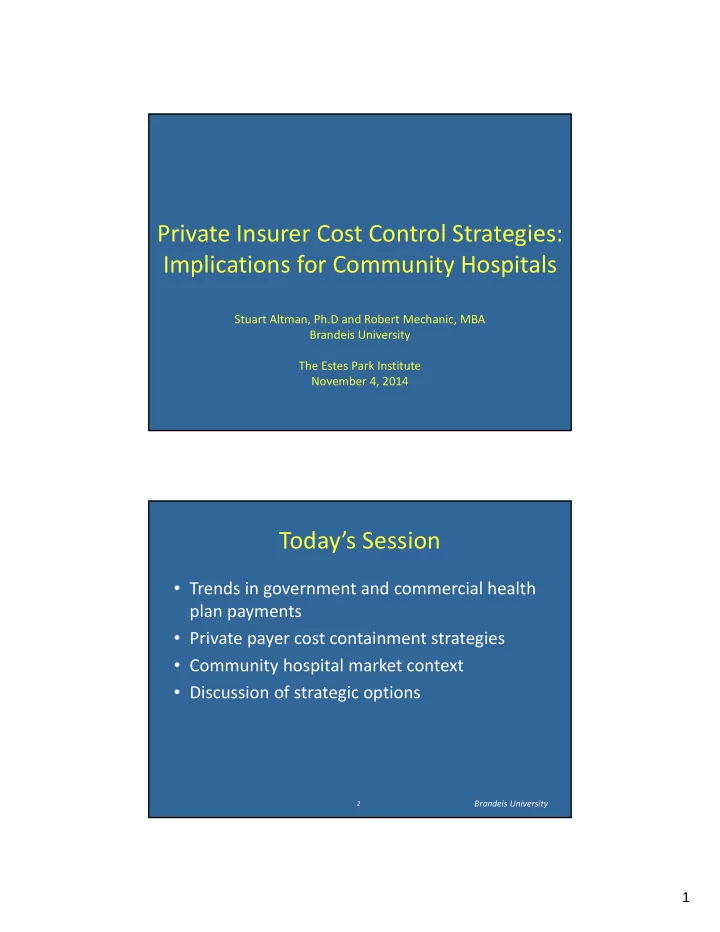

Private Insurer Cost Control Strategies: Implications for Community Hospitals Stuart Altman, Ph.D and Robert Mechanic, MBA Brandeis University The Estes Park Institute November 4, 2014 Today’s Session • Trends in government and commercial health plan payments • Private payer cost containment strategies • Community hospital market context • Discussion of strategic options Brandeis University 2 1
Slow Growth in Privately Insured Lives Will Intensify Competition for These Patients Growth in Enrollment by Payer Source, 2006 ‐ 2022 80 71% 70 Percent Change in Enrollment 57% 60 50 40 30 20 6% 10 0 Private Medicare Medicaid CMS, National Health Expenditure Projections, 2012 to 2022, January 2013. As a Result Government Payments Will Dominate The Healthcare System! 2
Private Payer Spending Growth Has Been Driven by Price Increases ‐ Not Volume Growth Expect Health Plans to Attack Prices – By Linking Them to What Consumers Have to Pay 2013 Private Per ‐ Person Spending Rose 3.9% Service Type 2013 Change Admissions ‐ 2.3% IP Prices +6.7% OP Visits ‐ 2.8% OP Prices +6.4% Brand Drugs ‐ 15.5% Brand Prices +21.2% Brandeis University 6 3
Emerging Payer Strategies • Tiered and narrow network plans • Defined contribution benefit plans and health exchanges (public & private) • Consumer cost sharing changes • Reference pricing + consumer incentives • Payment reforms Brandeis University 7 Narrow Network Health Plans Dominate Many Individual Exchanges 8 4
Narrow Networks Have Substantially Lower Premiums 9 How much volume will shift with a 15% premium discount? Broad Network = $500/mo Narrow Network = $425/mo Subsidy Based on Low Cost Plan Subsidy Dollar Narrow Broad Effective Subsidy Network Network Discount Premium Premium None $0 $425 $500 15% 50% $213 $213 $288 26% 75% $319 $106 $181 41% 90% $383 $42 $117 64% Brandeis University 10 5
Estimated Health Insurance Coverage in 2017 Total Nonelderly Population = 279 million Uninsured 10% Uninsured 19% Medicaid/CHIP 16% Medicaid/CHIP 13% Exchange 9% Private 10% Private Non-Group / 8% Non- Other Group/Other Employer- Employer- 58% sponsored 56% sponsored Insurance Insurance Without Health Reform With Health Reform (56 Million Uninsured) (29 Million Uninsured) NOTE: This assumes that all states choose to expand Medicaid eligibility up to 138% FPL January 2014. SOURCE: Congressional Budget Office, February 2013. Total may not equal 100% due to rounding Percentage of Large Firms Considering Offering Benefits Through a Private Exchange and the Percentage of Covered Workers Currently in a Private Exchange, by Firm Size, 2014 30% 200 ‐ 999 Workers 25% 1,000 ‐ 4,999 Workers 24% 25% 23% 23% 5,000 or More Workers 20% ALL LARGE FIRMS (200 or More Workers) 20% 18% 15% 13% 12% 10% 5% 3% 3% 3% 2% 0% Firm Considering Offering Benefits through Firm Considering a Defined Contribution Covered Workers Enrolled at a Firm a Private Exchange Approach Offering Benefits Through a Private or Corporate Exchange NOTES: 2% of large firms did not know if they were considering a private exchange and 3% did not know if they were considering a defined contribution approach. A private exchange is one created by a consulting company, not by either a federal or state government. Private exchanges allow employees to choose from several health benefit options offered on the exchange. SOURCE: Kaiser/HRET Survey of Employer ‐ Sponsored Health Benefits, 2014. 6
Brandeis University 13 Percentage of Covered Workers Enrolled in a Plan with a General Annual Deductible of $2,000 or More for Single Coverage, By Firm Size, 2006 ‐ 2014 50% All Small Firms (3 ‐ 199 Workers) All Large Firms (200 or More Workers) 40% All Firms 34% 31% 30% 28%* 27% 20% 18% 20% 16% 15% 14% 12%* 12%* 10% 10% 7% 7%* 11%* 5%* 6% 8% 3% 7% 3% 5% 4% 2% 3%* 1% 0% 1% 2006 2007 2008 2009 2010 2011 2012 2013 2014 * Estimate is statistically different from estimate for the previous year shown (p<.05). Note: These estimates include workers enrolled in HDHP/SO and other plan types. Average general annual health plan deductibles for PPOs, POS plans, and HDHP/SOs are for in ‐ network services. SOURCE: Kaiser/HRET Survey of Employer ‐ Sponsored Health Benefits, 2006 ‐ 2014. 7
Patients Are Paying More and Looking for Hassle Free Services That Cost Less Brandeis University 15 Large Employers Are Taking Matters into Their Own Hands Brandeis University 16 8
Brandeis University 17 Continuum of Payment Options What New Models Lie Between the Current Models? Fee ‐ For Shared Bundled Capitation/ Medicare Service Savings 1 Payment Risk ‐ Share Advantage with P4P Less Risk More Risk 1 With risk sharing starting in 3 ‐ 5 years. 18 9
Volume Value 19 Options Insurance Market Consolidated Competitive Collaborate with Local Consolidated Cultivate Support Insurer to Achieve Among Local Physicians “Reasonable” Spending and Key Employers Growth Hospital Market Move Aggressively to Promote Status as Earn Preferred Status “Must Have” Hospital Competitive with High ‐ Value Care and Aggressively Build and Population Health High ‐ Value Care Model Management 10
Do We Really Need Insurance Companies? Why Don’t We Cut Out the Middleman? Discussion of Options • For reducing unit costs? • For managing total medical expenses? • For new payment models? • For attracting more patients? • For partnering with health plans? Brandeis University 22 11
Questions Stuart Altman and Robert Mechanic The Heller School for Social Policy & Management The Health Industry Forum Brandeis University altman@brandeis.edu mechanic@brandeis.edu www.healthforum.brandeis.edu 23 12
Recommend
More recommend